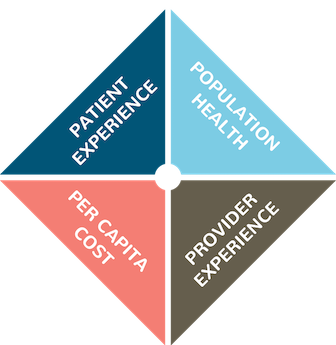Even with recent attempts to improve healthcare delivery, the U.S. healthcare system continues to face major challenges. According to 2019 data from the OECD, the U.S. spends 16.9% of gross domestic product on healthcare, nearly double that of the average developed country. Despite all of this spending, the U.S. also ranks last amongst the top 11 most developed countries for life expectancy and ranks first in chronic disease burden and hospitalizations due to preventable causes.
This misalignment between healthcare spending and outcomes is partially what prompted the Institute for Healthcare Improvement to develop The Triple Aim, a three-pronged approach to optimizing healthcare system performance:
- Reduce the per capita cost of healthcare
- Improve the patient experience of care
- Improve the health of populations
Recently, a fourth aim has been unofficially added to this guiding compass: improving the work life and satisfaction of healthcare providers, which subsequently improves care delivery for patients.
While there are many strategies that can help health plans accomplish one, two or even three of these aims, few services or programs deliver results for all four performance measures. Advance care planning (ACP), however, has been proven to deliver on all four aims, providing value to plans, members and physicians. Let’s take a closer look at how ACP accomplishes these goals.
1. Reduce the per capita cost of healthcare
ACP has been proven to reduce healthcare utilization and subsequent costs significantly by helping members avoid unnecessary and/or unwanted care. For example, after making ACP mandatory for all patients over 55, a healthcare system in La Cross, WI achieved:
- One week less inpatient time per patient during the last two years of life
- A $25,075 decrease in spending per patient in the last two years of life
When compared to Medicare’s national average spending, this healthcare system reduced costs by over 35% per patient through its robust ACP program.
Learn more about how health plans can reduce utilization with ACP in our free guide
2. Improve patient experience
ACP helps members align the care they receive with their personal goals and values, improving their care experience significantly. One study of end-stage medical illness patients and their family members found that patients who had a prognosis discussion with their physician — a key component of ACP — had higher satisfaction with overall care and were also more satisfied with the communication and decision-making aspects of care.
Additionally, ACP can improve the care experience for members’ caregivers and family members by alleviating the stress of making care decisions on the member’s behalf. A study published in the Annals of the American Thoracic Society confirms this, finding that 48% of surrogate decision makers for people with acute respiratory distress syndrome experience moderate or high levels of decisional conflict (score of 25 or higher on the Decisional Conflict Scale). In contrast, surrogates who engage in ACP conversations have significantly less decisional conflict, with a mean score 3.3 points lower on the Decisional Conflict Scale.
3. Improve the health of populations
There is evidence that ACP improves the health of populations by increasing both quality and length of life. A study of non-small-cell lung cancer patients determined that those who received
palliative care services, of which ACP is a core component, had significantly higher quality of life and fewer symptoms of depression. These patients also had 25% longer median survival times, despite receiving less aggressive care.
Similarly, a 2019 study published in BMJ concluded that, among seriously ill patients, those who had participated in ACP had a 16% higher 1 year survival rate than those who did not.
4. Improve healthcare worker satisfaction
Finally, and perhaps most surprisingly, ACP has been proven to improve physician satisfaction when delivered by a third party. In the current model, physicians feel pressured to deliver ACP, yet often find themselves unable to do so for a variety of reasons as reported by the Institute of Medicine:
- Two-thirds cited lack of time as their main barrier for facilitating ACP
- Others indicate their avoidance stems from psychological stress around delivering bad news and a combination of uncertainty and not wanting to insinuate hopelessness
Shifting delivery of ACP to an external partner can alleviate this stress on healthcare workers, which in turn helps improve their delivery of care.
Improving outcomes for everyone with ACP
ACP is a crucial service for health plans, serving as a quadruple aim solution that reduces costs and improves quality of care, health outcomes and healthcare worker satisfaction simultaneously. For health plans to reap the full benefits of ACP, it must be implemented consistently and with high quality at scale, requiring the development of intense internal operational capabilities.
Alternatively, a skilled third-party ACP partner can help your health plan provide robust ACP for all of your members without increasing the workload of your internal resources — leading to significant ROI. To learn more about how your plan can save with ACP, download our free case study 


